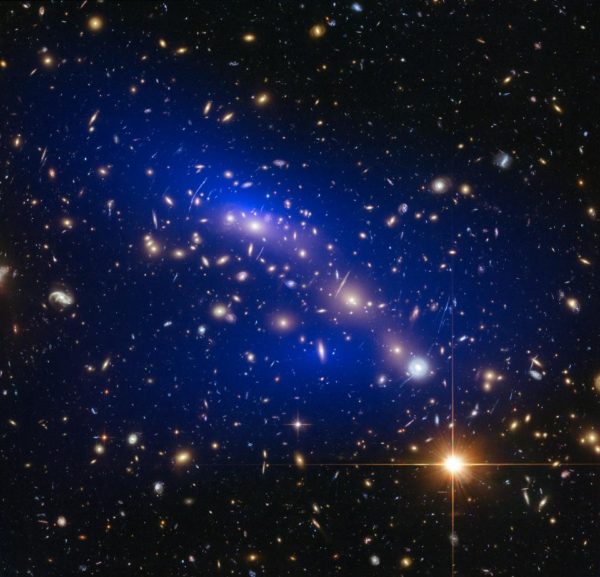"If something doesn’t reach you on a personal level, let it go. It’s hard enough dealing with everything that does." -Judi Culbertson
There are two types of electric charge: positive and negative. Like charges repel; opposite charges attract. In gravitation, though, there’s only one kind of gravitational charge, more commonly known as mass. And everything we know of has a positive mass. But since there’s a counterpart to matter -- antimatter -- isn’t it possible that antimatter would have negative gravitational charge, and fall “up” in a gravitational field?
 If there were some type of matter that had negative gravitational charge, it would be repelled by the matter and energy that we are aware of. Image credit: Muu-karhu of Wikimedia Commons.
If there were some type of matter that had negative gravitational charge, it would be repelled by the matter and energy that we are aware of. Image credit: Muu-karhu of Wikimedia Commons.
It sounds like it might be plausible, and that it’s something that should certainly be experimentally tested. Indeed, the direct measurements of gravitational acceleration of neutral antimatter are perhaps two orders of magnitude away from being able to definitively say that antimatter doesn’t do exactly that. But a combination of other theoretical and experimental results strongly disfavor anti-gravitation, not only for antimatter, but for any potential form of matter at all.
 The ultramassive, merging dynamical galaxy cluster Abell 370, with gravitational mass (mostly dark matter) inferred in blue. It's all attractive. Image credit: NASA, ESA, D. Harvey (Swiss Federal Institute of Technology), R. Massey (Durham University, UK), the Hubble SM4 ERO Team and ST-ECF.
The ultramassive, merging dynamical galaxy cluster Abell 370, with gravitational mass (mostly dark matter) inferred in blue. It's all attractive. Image credit: NASA, ESA, D. Harvey (Swiss Federal Institute of Technology), R. Massey (Durham University, UK), the Hubble SM4 ERO Team and ST-ECF.
Come get the full story as to why, courtesy of Sabine Hossenfelder!
- Log in to post comments

As far as I know creating particles with negative mass requires negative energy. Also negative energy known to exist but it is unknown if it can be created artificially.
Antimatter still positive energy. It's just of a form that is completely complementary to another particle. When they overlap, they cancel out, in just the same way as light destructively interferes and there's no electrical field at that place (therefore no illumination). When matter interacts like that, either they annihilate leaving just the energy (if they can pass momentum off to a nearby body) or it comes back as the same pair (or another shower of particles of the same energy and momentum).
Antimatter is still positive in mass-energy.
Gravitons are spin-2, which means they appear the same way to an "observer" directly in its path whether it is coming toward it or going away.
So there's no reliable way to get antigravity. No translation in space or velocity will manage it.
By the maths, if it were of imaginary mass, that may do it.
But I don't know of any way baryonic matter can be made to see a spin-2 particle like the graviton differently depending on whether it is "approaching" (making a repulsive force) or leaving (making an attractive force).
There may be a different force carrying particle to produce anti-gravity and that too would be invariant to direction of effect produced.
Electromagnetism,being mediated by a spin 1 force particle the photon, does look different based on "which way it's going", so it can produce attraction or repulsion, depending on how the mass reacts to the spin vector.
Note: the above may be 20 years out of date... But accurate enough for blogging.
Sabine wrote:
I'm not sure this is right. CERN Physicist Dragan Hajdukovic theorized that anti-gravity explained the MOND effect on galactic rotation curves. In one aspect at least it absolutely does explain an effect attributed to dark matter.
https://arxiv.org/ftp/arxiv/papers/1106/1106.0847.pdf
No, it explains an effect attributed to MOND.
It just happens, as it should. DM explains the observation too, but it's not an effect from dark matter, just the distribution of it.
Dang! There goes the Inertial Damper tech we need for FTL travel!
Depends. There's nothing in inertia that demands it be affected by gravity. There's a shit ton of evidence they are absolutely and for all reachable scales identical, and the Higgs field is partly formulated so as to ensure these two things do actually "by design" become the same measure.
But there's nothing that absolutely says that inertia is caused or mechanised by gravity.
If they were not the same, you could still have inertial dampers. Even artificial gravity.
Just not antigravity.
If
You are unfamiliar with the word?
Some other time perhaps ...
Buck buck buckaaawk!
So you said in bold letters "if". And some other time you'll expand on whatever idea it was supposed to represent.
When you've worked out what you can make it mean, I take it.
Commentators are, to my knowledge, free to squawk as often and as loudly as they care to.
Knowledge
The article states:
"An inertial mass is always positive valued."
But a recent publication contradicts this:
"Negative mass hydrodynamics in a spin-orbit--coupled Bose-Einstein condensate"
https://arxiv.org/abs/1612.04055